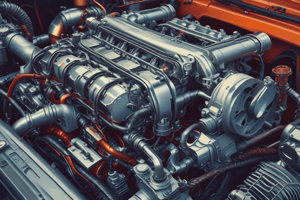Podcast
Questions and Answers
What is the primary function of an internal combustion engine?
What is the primary function of an internal combustion engine?
- To convert electrical energy into heat energy
- To convert mechanical energy into thermal energy
- To convert heat energy into mechanical energy (correct)
- To convert kinetic energy into potential energy
Which component of the internal combustion engine serves to connect the piston and the crankshaft?
Which component of the internal combustion engine serves to connect the piston and the crankshaft?
- Exhaust valve
- Crankshaft
- Spark plug
- Connecting rod (correct)
What is the primary function of a spark plug in an engine?
What is the primary function of a spark plug in an engine?
- To control the timing of the piston movements
- To compress the fuel and air mixture
- To deliver electric current to ignite the fuel/air mixture (correct)
- To exhaust burnt gases from the cylinder
During which phase of the operating cycle does the fuel/air mixture enter the cylinder?
During which phase of the operating cycle does the fuel/air mixture enter the cylinder?
How many strokes are completed in a four-stroke cycle per crankshaft revolution?
How many strokes are completed in a four-stroke cycle per crankshaft revolution?
What is the role of the exhaust valve in an internal combustion engine?
What is the role of the exhaust valve in an internal combustion engine?
During which stroke does the spark plug fire to ignite the fuel/air mixture?
During which stroke does the spark plug fire to ignite the fuel/air mixture?
Which of the following is NOT a basic part of an internal combustion engine?
Which of the following is NOT a basic part of an internal combustion engine?
What does a diesel engine do differently compared to a spark-ignition engine?
What does a diesel engine do differently compared to a spark-ignition engine?
What defines a reciprocating engine?
What defines a reciprocating engine?
What is the primary characteristic of a rotary engine?
What is the primary characteristic of a rotary engine?
Which efficiency is NOT typically associated with piston engines?
Which efficiency is NOT typically associated with piston engines?
What happens if the inlet valve is closed at bottom dead center (BDC)?
What happens if the inlet valve is closed at bottom dead center (BDC)?
What is the purpose of the piston in an internal combustion engine?
What is the purpose of the piston in an internal combustion engine?
What is valve overlap in the context of engine timing?
What is valve overlap in the context of engine timing?
Who is credited as the originator of the Otto Cycle used in four-stroke engines?
Who is credited as the originator of the Otto Cycle used in four-stroke engines?
Flashcards are hidden until you start studying
Study Notes
Engine Basics
- Internal combustion engines convert heat energy into mechanical energy.
- Gasoline vapor is mixed with air, compressed in a cylinder, and ignited by an electric spark.
Piston Engine Fundamentals
- Mechanical, thermal, and volumetric efficiencies are critical for performance.
- Operating cycles include Rotary, Diesel, 2-stroke, and 4-stroke configurations.
- Key terms: piston displacement and compression ratio impact engine power and efficiency.
Engine Requirements
- Quality engines are lightweight, reliable, durable, flexible, well-balanced, and possess an optimal weight per horsepower.
Reciprocating Engine
- Characterized by the back-and-forth movement of pistons within the engine.
Operating Principles
- The operational sequence of an internal combustion engine involves intake, compression, power/combustion, and exhaust.
Basic Parts of an Internal Combustion Engine
- Cylinder: Holds the air-fuel mixture for combustion.
- Intake/Exhaust Valves: Control the flow of air-fuel mixture into and exhaust out of the cylinder.
- Connecting Rod: Links the piston and crankshaft, transferring power.
- Piston: Moves within the cylinder and transfers force from combustion to crankshaft.
- Crankshaft: Converts the piston's reciprocating motion to rotational motion.
- Spark Plug: Ignites the fuel-air mixture via electric current in the combustion chamber.
Operating Cycles
Four-Stroke Cycle
- Requires two revolutions of the crankshaft (720°) for four strokes.
- Events:
- Intake/Induction
- Compression
- Power/Combustion
- Exhaust
Two-Stroke Cycle
- Completes in one crankshaft revolution, requiring one upstroke and one downstroke.
Diesel Cycle
- Comprised solely of air compression to ignite injected diesel fuel, named after Rudolf Diesel.
Rotary Engine Cycle
- Also called Wankel Engine; utilizes an eccentric rotary design to convert pressure into motion, invented by Felix Wankel.
Summary of Pressure and Volume Inside the Cylinder
- Dynamics of pressure and volume change during four-stroke cycles influence engine performance significantly.
Four-Stroke Valve Timing
- Top Dead Center (TDC): The highest position of the piston.
- Bottom Dead Center (BDC): The lowest position of the piston.
- Valve lead: Valve opens before the ideal time.
- Valve lag: Valve stays open beyond the ideal time.
- Valve overlap: Both the intake and exhaust valves are open simultaneously.
- Inlet valve timing is crucial to optimize cylinder filling; early opening ensures a full charge.
Studying That Suits You
Use AI to generate personalized quizzes and flashcards to suit your learning preferences.




